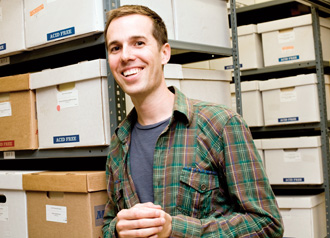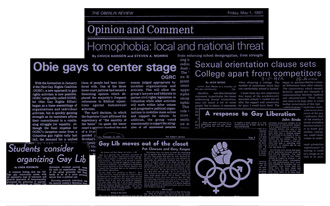Oberlin Alumni Magazine
Winter 2008-09 Vol. 104 No. 2
Out of the Past
 Joey Plaster at the GLBT Historical Society in San Francisco
Joey Plaster at the GLBT Historical Society in San Francisco

Oberlin graduate Joey Plaster takes steps to record and preserve Oberlin’s LGBT history.
Sophomore Harmony Pringle first learned of the Oberlin College LGBT Community History Project web site last fall while doing research for her journalism paper on Oberlin history.
Intrigued by the posting of an Oberlin Review item about an alleged fight that occurred in 1971 during a public dance in Wilder Hall hosted by Oberlin Gay Liberation, Oberlin’s first gay student group, she contacted the web site’s creator, Joey Plaster ’00. Plaster, in turn, connected her with members of the campus community from that era. Through interviews with faculty members, administrators, and former students, Pringle tried to establish what really happened at that dance in 1971. She shared an essay describing what she learned with Plaster, who posted it to his growing online archive.
This multidirectional collaboration is the core of the Community History Project, an ongoing, participatory memory bank that Plaster says "expands and grows as Oberlin students and alumni invent new, queer ways of interacting with the world." The site is "exemplary in being community-based and more wide-ranging than any others," says Oberlin Professor of History Clayton Koppes.
Plaster began his research into Oberlin’s gay history while still a student. Now, after 60-plus interviews with alumni, faculty, and staff, he has built an invaluable archive—unique among colleges and universities—of experiences hidden and almost forgotten. Personal stories, says Assistant Professor of Comparative American Studies Meredith Raimondo, are vital in expanding our knowledge about the history of lesbian, gay, bisexual, transgender, and queer organizations and institutions. The students’ experiences are also "an important, but often unrecognized, element of the history of social justice at Oberlin College."
Plaster’s original research spanned the 1920s through the early 1970s, decades prior to those covered by Into the Pink, a book published by the Oberlin Alumni Association in 1996 that compiled conversations with LGBT alumni at a reunion in 1991.
Plaster’s look into Oberlin’s earlier years debunked a longstanding presumption that there was no communal LGBT student or faculty activity on campus until the late 1960s, when the Stonewall riots in New York led to new gay and lesbian visibility and eventually inspired Oberlin’s first gay student organization in 1971.
Plaster compiled interviews with alumni into a narrative entitled Behind the Masks, which is now part of the Community History Project web site. Reprints of past Oberlin Review articles, campus speeches, and other historical documents flesh out a timeline of LGBT life on campus.
"One alum submitted a treasure trove of Review clippings and LGBT organizational records, as well as a whimsical ‘Oberlin lesbian survival map’ she found on campus around 1989," he says. Other postings include a letter from a parent to President Fairchild, written in 1878 after her child was punished for cross dressing; a series of diary entries from the 1940s and 1950s by a gay Conservatory student;and an audio clip from a 1971 alumni luncheon speech given by campus gay activist Patrick Broome ’71, who criticized Oberlin’s policies related to LGBT students.
Perhaps even more captivating than the documents are the personal stories offered by alumni themselves. Dozens of former students have added their own oral histories and narratives to the web site, documenting their diverse and divergent experiences through the years as members of the LGBT community.
"In the decades preceding the 1970s, you have, on the one hand, kids sulking in their rooms and contemplating suicide, and on the other hand, fabulous queers having a great time in their ‘secret societies,’ finding gay professors who would mentor them, and claiming spaces of their own," says Plaster.
There was no ‘outing’ of someone or a sense of spreading rumors…We were very protective of one another. [We used] first names basically, not saying anything to the administration or the professors. …It was nice to know there were other like-minded fellows there who weren’t trying to get themselves kicked out. —Rev. Robert Wood GST ’51
[Any mention of homosexuality was] very, very rare, and always with a negative connotation. …So that, I think really characterizes the period, of the real invisibility—the historical and literary invisibility of what it was that we felt ourselves attracted to. And that of course made it much more difficult, when there was no historical or public affirmation of people who felt the way we do. —Bill Vance ’56
Plaster attributes the divergence of student experiences to the silence and invisibility of the era, and to differences in individual psychology and personality. But LGBT communities were also fragmented by other differences, such as class, race, and gender.
[Oberlin was] where I recognized that there was discrimination among gay people—much to my surprise. There were certain clubs that didn’t want black kids. …There were times when I felt that the white gays stayed away from the black gays. —Francois Clemmons ’67
In light of the fact that I later became a gay activist and became sort of a prominent out politician, maybe it’s surprising that I was so completely closeted when I was in college, but I guess that’s just an indication of how things changed between the mid ’50s and the early ’70s. …[Oberlin] didn’t prepare me to be "out," [but] it prepared me for liberal politics, for liberation movements I guess you could say, in the broader sense of the word. —Allan Spear ’58
Many of the lesbian narrators, says Plaster, didn’t develop a strong lesbian identity until well after Oberlin.
When I saw and spent time with lesbians and bisexual women on campus and felt like I had nothing in common with them, I didn’t think about this in terms of class and culture. I thought about this in terms of sexuality. Even though I had had a girlfriend up until I was 15 and had been sexual with girls extensively and not at all with guys, I assumed I must not be queer because I wasn’t like those who were. —Susan Raffo ’85
Conducting the oral histories and research, says Plaster, was part of a personal transformation that Oberlin nurtured. "It gave me models of LGBT adult life, reinforced my confidence in the power of social activism, and inspired pleasure and pride in queer resiliency and inventiveness."
He acknowledges that the history project contains significant gaps, particularly with regard to the stories of women, transgendered individuals, and people of color. These are holes Plaster is working to fill. In 2007, he attended a reunion of Oberlin Lambda Alumni, where he led an oral history workshop for students who wanted to record interviews with alumni. Audio clips and transcripts of many of these interviews have been posted to the web site.
Interesting to Professor Raimondo is "the idea of using the web as both a publishing form and an archive." She feels that "this strategy allows the narrative to continue to grow and to be accessible to lots of different people. It maintains the participatory nature of community history projects and uses it to renew and develop community through the project."
At first, Harmony Pringle’s research into the 1971 Gay Lib Dance proved inconclusive. Many of the individuals she contacted did not even remember a fracas breaking out. Finally, Oberlin Gay Liberation co-founder Pat Clawson ’73 informed her that the fight occurred between an African American "townie" and a straight, white male student, and had more to do with race than sexuality.
Pringle’s research raises as many questions as it answers. "We can’t really draw any conclusions about Oberlin’s LGBT history if these stories are not known," Plaster points out. Going forward, he adds, the contributions of Oberlin community members—past and present—will be invaluable in overcoming these limitations.
Explore the Community History Project at www.oberlinlgbt.org.
Peter Nicholson is founder and executive director of the Foresight Design Initiative in Chicago. Read his author’s statement at www.oberlin.edu/oam.
